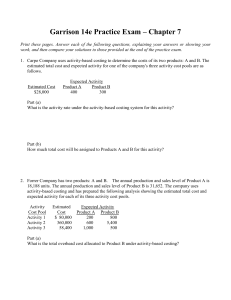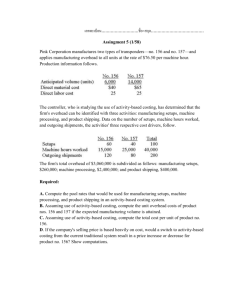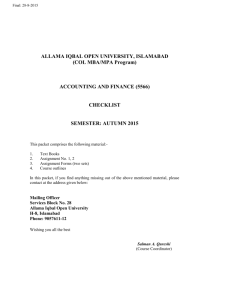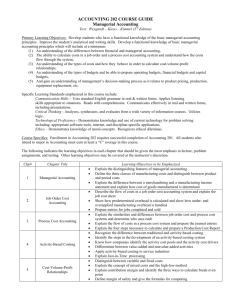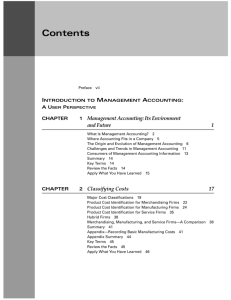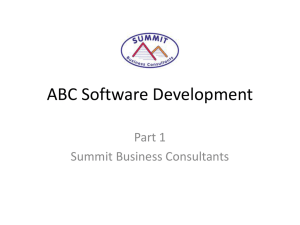CHAPTER 24 Activity-Based Costing (ABC)
advertisement
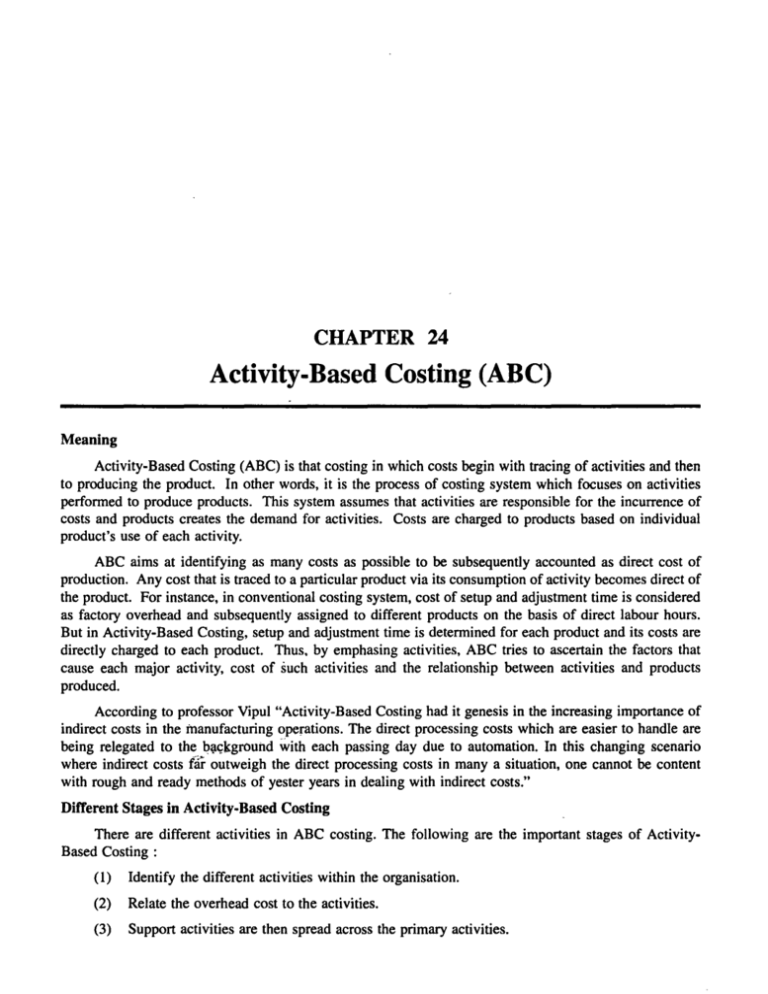
CHAPTER 24 Activity-Based Costing (ABC) Meaning Activity-Based Costing (ABC) is that costing in which costs begin with tracing of activities and then to producing the product. In other words, it is the process of costing system which focuses on activities performed to produce products. This system assumes that activities are responsible for the incurrence of costs and products creates the demand for activities. Costs are charged to products based on individual product's use of each activity. ABC aims at identifying as many costs as possible to be subsequently accounted as direct cost of production. Any cost that is traced to a particular product via its consumption of activity becomes direct of the product. For instance, in conventional costing system, cost of setup and adjustment time is considered as factory overhead and subsequently assigned to different products on the basis of direct labour hours. But in Activity-Based Costing, setup and adjustment time is determined for each product and its costs are directly charged to each product. Thus. by emphasing activities, ABC tries to ascertain the factors that cause each major activity, cost of such activities and the relationship between activities and products produced. According to professor Vipul "Activity-Based Costing had it genesis in the increasing importance of indirect costs in the manufacturing operations. The direct processing costs which are easier to handle are being relegated to the b\l<;;kgrouild with each passing day due to automation. In this changing scenario where indirect costs outweigh the direct processing costs in many a situation, one cannot be content with rough and ready methods of yester years in dealing with indirect costs." (ar Different Stages in Activity-Based Costing There are different activities in ABC costing. The following are the important stages of ActivityBased Costing : (1) Identify the different activities within the organisation. (2) Relate the overhead cost to the activities. (3) Support activities are then spread across the primary activities. Activity-Based Costing (ABC) 5/3 (4) Determine the activity cost drivers. (5) Calculate the activity cost drivers rate, i.e., the quantity of cost driver used by each product. ABC and Cost Drivers In Activity-Based Costing, activities are identified and classified into different categories that have relationship with the different stages or parts of the production process. The factors that influence the cost of a particular activity are known as "Cost Drivers." A Cost Driver is literally the factors, forces or events that determine the cost of activities. The process of activity-based costing is based on the assumption that cost behaviour is influenced by cost drives. It should be understood that direct costs do not need cost drivers because direct costs are themselves cost drivers. They can be traced by direct relationship with the different parts of product. However, all other factory, office and administrative overheads need cost drives. Examples of Cost Drivers In order to trace overhead costs to manufacturing a product, suitable Cost Drivers should be identified. The following are the few examples of Cost Drivers in Activity-Based Costing: Cost Drivers (1) (2) (3) (4) (5) (6) (7) (8) (9) (to) (11) Number of receiving order Number of deliveries Number of Purchase orders Kilometres travelled per delivery Number of customers' visits Number placing orders for purchase Number of returning or empty bottles Number Material handling hours Amount of labour cost incurred Number of inspections Number of physical delivery and} receipt of goods Activity Ordering Delivery Order Taking Deliveries Customer Visit Placing Orders Bottles Returns Product Handling Labour Transactions Inspection Delivery Classification of Activities In the first stage of the Activity-Based Costing activities are identified and classified into different categories or segments of the production process. The grouping of activities is preferably done using the different levels at which activities are performed. Broadly, activities are classified into: (1) Unit Level Activities (2) Batch Level Activities (3) Product Level Activities (4) Facility Level Activities (1) Unit Level Activities: Unit Level Activities are those activities which are performed each time a single product or unit is produced. These activities are repetitive in nature. For example, direct labour hours, machine hours, powers etc. are the activities used for each time for producing a single unit. Direct materials and direct labour activities are also unit level activities, although they do not overhead costs. Cost of unit level activity vary with the number of units produced. A Textbook of Financial Cost and Management Accounting 514 (2) Batch Level Activity: These activities which are performed each time a batch of products or group of identical products are produced. All the units of a particular batch are uniform in nature and in size. The cost of batch level activities vary with the number of batches are ascertained. Machine setups, inspections, production scheduling, materials handling are examples of batch level activities which are related to batches. (3) Product Level Activities: These activities which are performed to support the production of each different type of product. Maintenance of equipment, engineering charges, testing routines, maintaining bills of materials etc. are the few examples of product level activities. (4) Facility Level Activities: Facility Level Activities are those which are needed to sustain a factory's general manufacturing process. These activities are common to a variety of products and are most difficult to link to product specific activities. Factory management, maintenance, security, plant depreciation are the few examples of facility level activities. Difference Between Activity-Based Costing and Conventional Costing Conventional Costing (or) Traditional Costing Activity-Based Costing (I) It begins with identifying activities and then to producing the products (1) It begins with identifying cost and then to producing the products (2) It mainly focuses on activities performed to produce products (2) It emphasises mainly on ascertainment of costs after they have been incurred (3) Cost Drivers used for identifying the factors that influence the cost of particular activity (3) Cost unit is used for allocation and accumulation of costs (4) Overhead costs are assigned to Cost Centre or Cost Pools (4) Overhead costs are assigned to production departments or service departments (5) Overhead costs are assigned to products using Cost Drivers Rates (5) Overheads allocated on the basis of departmental overhead allocation rate (6) Variable overhead is appropriately identified to individual products (6) Costs may be allocated or assigned either on actual cost incurred or on standard cost basis (7) In ABC many activity based on Cost Pools or Cost Centres are created (7) Overheads are pooled and collected department wise (8) There is no need to allocate and redistribution of overhead of service departments to production departments (8) The process of allocation and re-distribution of the costs of the service departments to production department is essential to find out total cost of production (9) It assumes that fixed overhead costs vary in proportion to changes in the volume of output. (9) It assumes that fixed overheads do not vary with changes in the volume of output. Activity-Based Costing (ABC) 515 Advantages of Activity-Based Costing ABC system is a very valuable tool of control. It offers a number of advantages to the management and the following are the main advantages : (I) It brings accuracy and reliability of the costing data in determination of the cost of the products_ (2) It facilitates cause and effect relationship to exercise effective cost control. (3) It provides necessary cost information to the management to take decisions on any matter, relating to the business_ (4) It is much helpful in fixing the cost and selling price of a product. (5) It facilitates overhead costs allocate directly to the specific product. (6) It enables to manage the activities rather than costs. (7) It helps to remove all types of wastages and inefficiencies. (8) It provides valuable information to evaluate on the relative efficiencies of various plants and machinery. (9) Cost Driver Rates will help in significant impact on the development of new products or modification of existing products. Essentials Factors of a Good Activity-Based Costing System The success of the Activity-Based Costing system depends on the following factors: (1) Objectives of costing system and level of competition. (2) Number of products manufactured. (3) Product diversity and the business_ (4) Adaptation of cost management measures, standardization and technical aspects. (5) Degree of sophistication and suitability to the firm. (6) Determination of single or combined Cost Driver. (7) Determination number of Activity Centre, Cost Pools and Cost Drivers. (8) Determin.ation of total overhead costs and economy. (9) Evaluation of trade off between measurement of costs and cost of errors. (10) Elasticity and adoptive to the changing circumstances. Illustration: 1 Indian pottery company is noted for a full line of quality products. The company operates one of the plants in Mumbai. That plant produces two types of products: Indian design A, and contemporary B, Rajan the president of the company, recently decided to change from a volume-based costing system to an activity-based costing system. Before making the change company wide he wanted to assess the effect on the product cost of the Mumbai plant. This plant was chosen because it produces only two types of products, most other plants produced at least a dozen. To assess the effect of the change, the following data have been gathered : A Textbook of Financial Cost and Managemelit Accounting 516 Products Quantity Prime Cost Machine Hours Material Moves Setups Indian A Contemporary B 2,00,000 50,000 7,00,000 1,50,000 50,000 12,500 7,00,000 1,00,000 100 50 8,50,000 2,50,000 3,00,000 15,000 Total Value (Rs.) Rs. 2,50,000 is the cost of maintenance of machine. Under the current system, the cost of maintenance, material handling and setups are assigned to the products on the basis of machine hours. Required (1) (2) Compute the unit cost of each product using the current unit-based approach. Compute the unit cost of each product using an activity-based costing approach. Solution: (1) Total overhead is Rs. 10,00,000. The plant wide rate is Rs. 16 per machine hour (Rs. 10,00,000 '"' 6,25,000) Overhead is assigned as follows : Indian A Contemporary B = Rs. 16 =Rs. 8,00,000 x 50,000 = Rs. 16 x 12,500 = Rs. 2,00,000 The unit costs for the two products are as follows : Indian = Rs. 8,00,000 + 7,00,000 = Rs. 7.50 2,00,000 Contemporary (2) = Rs. 2,00,000 + 1,50,000 = Rs. 7.00 50,000 In the activity-based approach, the consumption ratios are different for all three overhead activities, so overhead pools are formed for each activity. The overhead rates for each of these pools are as follows : Maintenance = Material handling = Setup = Rs. 2,50,000 :;: R3. 4 per hour 62,500 Rs. 3,00,000 8,00,000 Rs. 4,50,000 150 =Rs. 0.375 per move =Rs. 3,000 per setup Overhead is assigned as follows. : Rs. Indian A: Maintenance Material handling Setup Cost = = = Rs. 4 x 50,000 Rs. 0.375 x 7,00,000 Rs. 3000 x 100 Total Overhead = = = = 2,00,000 2,62,500 3,00,000 7,62,500 Activity-Based Costing (ABC) 5/7 Contemporary B : Rs. Maintenance Material handling Setup Costs = = = Rs. 4 x 12,500 Rs. 0.375 x 1,00,000 Rs. 3000 x 50 Total Overhead = = = = 50,000 37,500 1,50,000 2,37,500 This produces the following unit costs Indian A: Rs. Prime Cost Add : Total Overhead Costs Total Costs Units Produced Unit Cost Rs. 14,62,500 = 2,00,000 = = = = 14,62,500 2,00,000 units = Rs. 7.31 per unit Contemporary B : Rs. = = = = Prime Cost Add : Total Overhead Costs Total Costs Units Produced = Unit Cost 7,00,000 7,62,500 Rs. 3,87,500 50,000 1,50,000 2,37,500 3,87,500 50,000 units =Rs. 7.75 per unit Illustration: 2 Family store wants information about the profitability of individual product lines: Soft drinks, Fresh Produce and Packaged food. Family store provides the following data for the year 2002-03 for each product line : Particulars Revenues Cost of goods sold Cost of bottles returned Number of purchase orders placed Number of deliveries Received Hours of shelf-stocking Time Items sold Soft Drinks Fresh Produce Packaged Food Rs. 7,93,500 Rs. 6,00,000 Rs. 10,000 360 300 540 1,26,000 Rs.21,00,600 Rs. 15,00,000 Rs. 12,09,900 Rs. 9,00,000 Rs.O 360 660 2,700 3,06,000 ° Rs. 840 2,190 5,400 11,04,000 518 A Textbook of Financial Cost and Management Accounting Family store also provides the following information for the year 2002-2003 Activity Description of Activity Total Cost Bottles returns Returning of empty-bottles to store Ordering Delivery Placing of orders for purchases Physical delivery and receipt of goods Stocking of goods on store shelves } and On-going restocking } Assistance provided to customers including check-out Shelf stocking Customer support Cost - allocation Base Rs.12,ooO . Direct tracing to soft-drink line 1,560 purchase orders Rs. 1.56,000 Rs. 2,52,000 Rs. 1,72,800 3,150 deliveries 8,640 hours of } shelf-stocking time Rs. 3,07,200 15,36,000 items sold Required (l)" (2) (3) Family store currently allocates support cost (all costs other than cost of goods sold) to product lines on the basis of cost of goods sold of each product line. Calculate the operating income and operating income as a % of revenues for each product line. If family store allocate support costs (all costs other than cost of goods sold) to product lines using an Activity-Based Costing System, calculate the operating income as a % of revenues for each product line. Comment on your answers in requirement (1) and (2) rCA, May, 2003 J Solution: (i) Calculation of Operating Income and Operating Income as a % of revenues for each product line : Particulars Soft Drinks Rs. Fresh Produce Rs. Packaged Foods Rs. Revenues 7,93,500 21,00,000 12,09,900 41,04,000 Cost of Goods Sold Store Support Cost (30%) 6,00,000 1,80,000 15,00,000 4,50,000 9,00,000 2,70,000 30,00,000 9,00,000 Total Cost 7,80,000 19,50,000 11,70,000 39,00,000 13,500 1,50,600 39,900 2,04,000 1.70% 7.17% 3.30% 4.97% Operating Income Operating Income} as % of revenue (ii) Total Rs. The activity rates are as follows : Activity Ordering Delivery Shelf Stocking Customer Support Cost Hierarchy Batch Level Batch Level Output Unit Level Output Unit Level Total Cost Rs. 1,56,000 2,52,000 1,72,800 3,07,200 Qty. of Cost Allocation Base + 1,560 Purchase Orders + 3,150 delivers + 8,640 hours + 15,36,000 items sold Overhead Allocation Rate =Rs. 100 per order =Rs. 80 per delivery =Rs. 20 per hour =Rs. 0.20 per items sold 519 Activity-Based Costing (ABC) Cost Allocation Statement Under Activity-Based Costing System Particulars Revenues (1) Cost of goods sold Bottle - Return cost Ordering cost } @ Rs. 100 Delivery cost } @ Rs. 80 Shelf stock cost } @ Rs. 20 Customer support cost } @ Rs. 0.20 Total Cost (2) Soft Drinks Rs. Packaged Foods Rs. Total Rs. 7,93,500 21,00,000 12,09,900 41,04,000 6,00,000 12,000 36,000 (360 x 100) 24,000 (300 x 80) 10,800 (540 x 20) 25,200 (1,26,000 x 0.20) 15,00,000 9,00,000 84,000 (840 x 1(0) 1,75,000 (2,190 x 80) 1,08,000 (5,400 x 80) 2,20,800 (ll,04,OOO x 0.20) 36,000 (360 x 100) 52,800 (660 x 80) 54,000 (2700 x 20) 61,200 (3,06,000 x 0.20) 30,00,000 12,000 1,56,000 7,08,000 20,88,000 11,04,000 39,00,000 85,500 12,600 1,05,900 2,04,000 10.78% 0.60% 8.75% 4.97% Operating Income } (1) - (2) Operating Income as % } of Revenue (iii) Fresh Produce Rs. - - 2,52,000 1,72,800 3,07,200 Managers believe the Activity-Based Cost (ABC) system is more credible than the previous costing system. The ABC system distinguishes the different type of activities at Family store more precisely. It also tracks more precisely how individual product lines use resources. Soft drink consume less resources than either fresh produce or packaged food. Soft drinks have fewer deliveries and require less Shelf-Stocking time. Managers of Family Stores can use ABC information to guide their decisions, such as how to allocate a planned increase in floor space. Pricing decisions can also be made in a more informed way with ABC information. Illustration: 3 Alpha Limited has decided to analyse the profitability of its few new customers. It buys bottled water at Rs.90 per case and sells to retail customers at a list price of Rs.108 per case. The data pertaining to five customers are : Particulars Case Sold List selling price Actual selling price Number of purchase Orders Number of customer Visits Number of Deliveries Kilometers traveled Per delivery Number of expedited Deliveries A B C D E 4,680 Rs.108 Rs.108 15 2 10 20 0 19,688 Rs.108 Rs.106.20 25 3 30 6 0 1,36,800 Rs.108 Rs.99 30 6 60 5 0 71,550 Rs.108 Rs.I04.4O 25 2 40 10 0 8,775 Rs.108 Rs.97.20 30 3 20 30 1 A Textbook of Financial Cost and Management Accounting 520 Its five activities and their cost drivers are : Activity Cost Driver Rate Order taking Customer visits Deliveries Product handling Expedited deliveries Rs. Rs. Rs. Rs. Rs. 750 per purchase order 600 per customer visit 5.75 per delivery k.m. travelled 3.75 per case sold 2,250 per expedited delivery Required (i) (ii) (iii) Compute the customer level operating income of each of five retail customers now being examined (A,B,C,D, and E); comment on the results. What insights are gained by reporting both the list selling price and the actual selling price for each customer? What factors Alpha Ltd. should consider in deciding whether to drop one or more of five customers? [CA, Nov. 2003J Solution: A B C D Revenues at List Price Less: Discount 5,05,440 Nil 21,26,304 35,438 1,47,74,000 12,.31,200 77,27,400 2,57,580 9,47,700 94,770 Revenues at Actual Price Less : Cost of Goods sold at Rs. 90 per unit 5,05,440 4,21,200 20,90,866 17,71,920 1,35,43,200 1,23,12,000 74,69,820 64,39,500 8,52,930 7,89,750 84,240 3,18,946 12,31,200 10,30,320 63,180 11,250 (750 x 15) 18,750 (750 x 25) 22,500 (750 x 30) 18,750 (750 x 25) 22,500 (750 x 30) 1,200 1,800 3,600 1,200 1,800 1,150 1,035 1,725 2,300 3,450 17,550 73,830 5,l3,ooo 2,68,3l3 32,906 Particulars Gross Margin (A) Customer Level Operating Cost Order taking @ Rs. 750 Customer Visits @ Rs. 600 Delivery Vehicles (Rs. 5.75 per Km) Product handling Rs. 3.75 per case Expected runs (Rs. 2250 per run) - - - E - - Total Costs (B) 31,150 95,415 5,40,825 2,90,563 62,906 Customer Level Operating Income (A) - (B) 53,090 2,23,531 6,90,375 7,39,757 274 (i) Customer D is the most profitable customer, despite having only 52.30% of the unit volume of customer C. A major exploitation is that customer C receives at Rs.9 discount per case while customer D receives only at Rs.3.60 discount per case. Customer E is less profitable, in comparison with the small customer A being profitable. Customer E received a discount of Rs.1D.80 per case, make more frequent orders, requires more customer visits and requires more delivery kms, in comparison with customer A. (ii) Separate reporting of both the listed selling price and the actual selling price enables Alpha Ltd. to examine which customer receives different discount documents and how sales people may differ in the discounts they grant. There is a size pattern in the discount across the 5 customers, except for customer E. 52! Activity-Based Costing (ABC) Discount Per Case Sales Volume C 0,36,800 Cases) D (71,550 Cases) B (19,688 Cases) E (8,775 Cases) A (4,680 Cases) 12,31,200 2,57,580 35,438 94,770 4,680 1,36,800 71,550 19,688 8,775 4,680 = = = = = Rs.9 Rs.3.60 Rs. 1.80 Rs.IO.80 Rs.O The reasons for the Rs. 10.80 discount for customer E should be explored. (iii) Dropping customers should be the last resort taken by Alpha Ltd. Factors to be considered include: What is the expected future profitability of each customer? Are the currently unprofitable (E) or low profitable (A) customers likely to be highly profitable in the future? What costs are avoidable if one or more customers are dropped? Can the relationship with "problem" customers be restructured so that there is a 'win win' situation? QUESTIONS 1. 2. 3. 4. 5. 6. 7. What do you understand by Activity-Based Costing? What is meant by Cost Driver? Explain role of Cost Driver in tracing costs to products. Explain the stages in applying ABC in manufacturing company. Explain the difference between Activity-Based Costing and Traditional Costing System? What are the advantages of Activity-Based Costing? What are the classification of activities? Explain it briefly. What are the factors to be considered while adopting ABC? DOD

